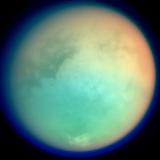Astronomers are coming to believe that some of the solar system's moons might be more likely places to search for life than Mars.
Whether there is life on Titan, the largest moon of Saturn, is at present an open question and a topic of scientific assessment and research.
Titan is far colder than Earth, and its surface lacks stable liquid water, factors which have led some scientists to consider life there unlikely. On the other hand, its thick atmosphere is chemically active and rich in carbon compounds. On the surface there are bodies of liquid methane and ethane, and it is likely that there is a layer of liquid water under its ice shell; some scientists speculate that these liquid mixes may provide pre-biotic chemistry for living cells different from those on Earth.
That's not all.
One of Jupiter's four large moons, Europa is the most promising in terms of habitability because of its relatively thin ice shelf and subsurface ocean. And we know there are oxidants on the surface of Europa. Those oxidants take the form of reddish deposits around the many fractures and fissures that lace the icy surface of the satellite. Red, orange and yellow colors are often a tell-tale sign of organic molecules.



